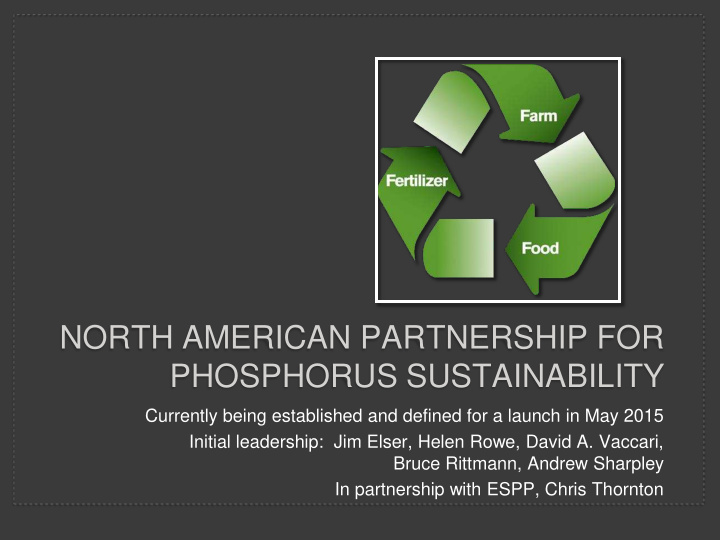



s’ NORTH AMERICAN PARTNERSHIP FOR PHOSPHORUS SUSTAINABILITY Currently being established and defined for a launch in May 2015 Initial leadership: Jim Elser, Helen Rowe, David A. Vaccari, Bruce Rittmann, Andrew Sharpley In partnership with ESPP, Chris Thornton
Impetus for NAPPS • • Phosphorus Sustainability Research The P-RCN seeks to Coordination Network (P-RCN) link research with stakeholder was created in 2013 with a grant from the needs US National Science Foundation • NAPPS proposed at the • 2 nd P-RCN meeting – Jan 2014 Centered at Arizona State University
The goal of NAPPS is to work actively with stakeholders to foster and implement sustainable P solutions in public and private sectors. • NAPPS will identify and endeavor to alleviate key bottlenecks for decision-making, policy, and implementation of P efficiency and recycling technologies and strategies • NAPPS will create an operational approach to facilitate business, policy and regulatory developments, implement projects, and translate research progress into phosphorus management actions • Stakeholders include national and local policy makers, regulators, planners and officials, representatives of agriculture, mining and other industry, and academia
Niche for NAPPS • NAPPS aims to be a lasting structure focused on the long-term implementation of P sustainability solutions in North America • NAPPS will engage stakeholders with each other • NAPPS will be a resource for creating and mobilizing a network, project development, finding funding for projects to address identified priorities • NAPPS will collaborate, building on and work with other P sustainability organizations, e.g. ESPP, Global P summit, Global P Network, UN-GPNM
NAPPS activities and stakeholder recruitment will be organized around these four themes: 2. P Efficiency in Food Production 1. P Recycling 3. P Demand: Population, food choice, bioenergy 4. P and Water Quality
Representative Activities 1. Develop a common vision for creating a sustainable P cycle in North America 2. Identifying and helping businesses and other organizations respond to opportunities offered by challenges in P management and emerging research in P sustainability 3. Building networks between different interest groups and sectors related to phosphorus management 4. Evaluating new P efficiency and recycling technologies , including feasibility, availability of suppliers, cost/benefit analysis, and life cycle analyses 5. Fostering implementation of new technologies by improving the efficiency of business value chains 6. Assessing and facilitating regulatory development pertaining to phosphorus management, including waste, environmental, discharge, and agriculture to improve P sustainability 7. Representing stakeholders North American phosphorus managers and innovators in international meetings and initiatives 8. Preparing funding proposals for demonstration projects and integration and dissemination of new technologies and concepts
Funding: Current “start up” funding is from Arizona State University Investment from future partners: • P-recycling or P-engineering companies • Agricultural companies: crops, seeds, feeds, crops • Livestock industry, manure processing • Biofuels companies • Water and waste utilities and companies • Food processing & retailing Phosphate Rock industry • Municipalities, local and state authorities • Gov’t agencies: USDA, EPA
Recommend
More recommend